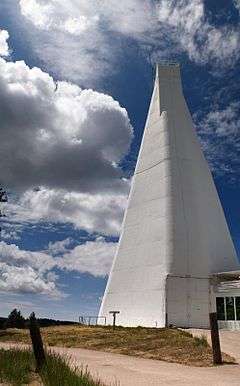National Solar Observatory
 | |
| Organization | Association of Universities for Research in Astronomy |
|---|---|
| Website |
www |
| Telescopes | Richard B. Dunn Solar Telescope, McMath–Pierce Solar Telescope |
|
| |
The National Solar Observatory carries out research into the Sun as an astronomical object and as the dominant external influence on Earth. It provides its observations to the scientific community. It operates facilities, develops advanced instrumentation both in-house and through partnerships, conducts solar research, and carries out educational and public outreach.
The National Solar Observatory operates facilities at two locations, at Sacramento Peak near Sunspot in New Mexico, and at Kitt Peak in Arizona.
A major feature of the Richard B. Dunn Solar Telescope at Sacramento Peak is a de-rotated 100 meter vacuum column.
Visiting the observatories
The National Solar Observatory at Sacramento Peak welcomes visitors during the daytime. There is a separate, nighttime observatory, Apache Point Observatory, located nearby. The observatory lies in New Mexico at the southern end of NM Scenic Byway 6563, about 18 miles (by car) south of Cloudcroft (on NM 82), and 40 miles southeast (by car) from Alamogordo (on NM 70 and 54), in the village of Sunspot inside of the Lincoln National Forest. Sunspot is an unincorporated community in the Sacramento Mountains in Otero County.
The National Solar Observatory in Arizona is located in Tucson and at Kitt Peak, which is 56 miles southwest of Tucson via State Route 86 on the Tohono O'Odham Reservation. Allow 90 minutes of drive time from Tucson.
The National Solar Observatory is operated by the Association of Universities for Research in Astronomy under a cooperative agreement with the National Science Foundation, for the benefit of the astronomical community.
Telescopes operated by the observatory
Sacramento Peak
- The Richard B. Dunn Solar Telescope
- The Evans Solar Facility
- Hilltop Dome Facility
- See Apache Point Observatory for the telescopes located there
Kitt Peak
- McMath-Pierce Solar Telescope
- Kitt Peak Solis Telescope
Global
History
The Sacramento Peak facilities are located in Sunspot, New Mexico. The site's name was chosen by the late James C. Sadler, (1920–2005), an internationally noted meteorologist and professor at The University of Hawaii, formerly with the United States Air Force on assignment during the early inception of the observatory.[1]
References
- ↑ Zirker, J. B. (1998). "The Sacramento Peak Observatory". Solar Physics (182). pp. 1–19.
Further reading
- Britt, Robert Roy (December 8, 2006). "Scientists spot 'tsunami' on the sun". NBCNews.com.
- Liebowitz, R. P. (2002). "Donald Menzel and the creation of the Sacramento Peak Observatory". Journal for the History of Astronomy. 33 (111). pp. 193–211. ISSN 0021-8286. Retrieved March 3, 2015.
External links
- Official website
-
 Media related to National Solar Observatory at Wikimedia Commons
Media related to National Solar Observatory at Wikimedia Commons
Coordinates: 32°47′17″N 105°49′12″W / 32.788°N 105.820°W